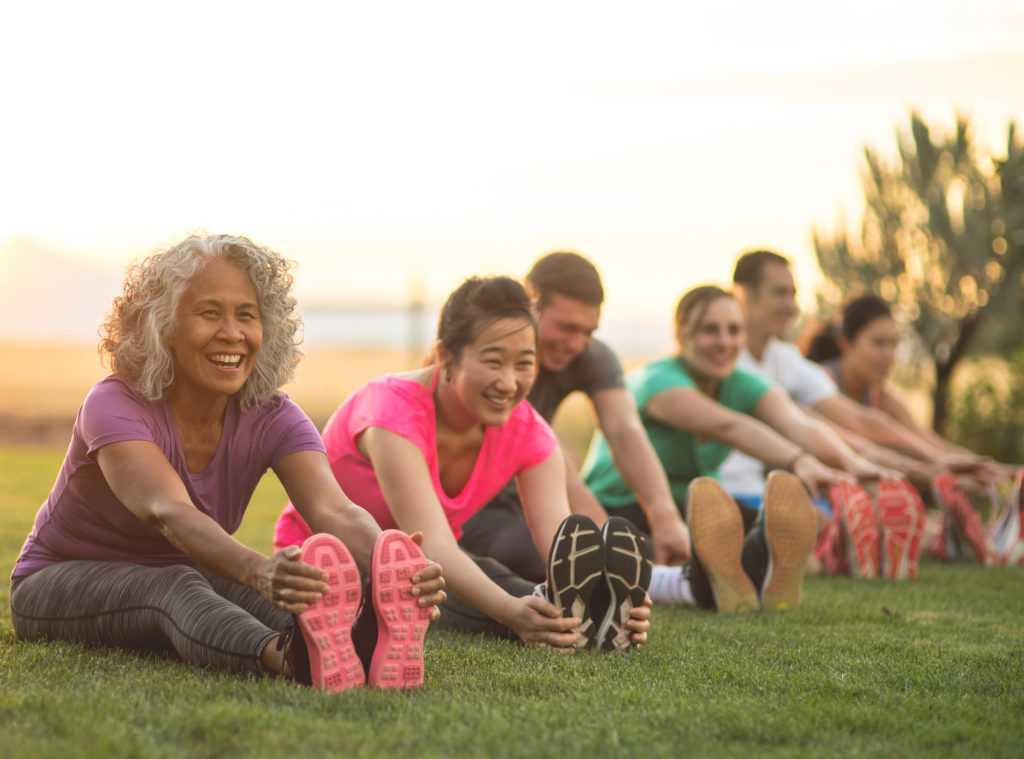Be Flexible To Be In Shape

“Blessed are the flexible for they will not allow themselves to become bent out of shape!” – Robert Ludlum (attributed)
Part of the aging process is losing flexibility as joints become stiffer. In fact, a 2013 research study found that those aged 55 to 86 years lose flexibility in the shoulder and hip joints at approximately 6 degrees per decade; those 70 years and older can experience more significant declines. The lack of flexibility not only prevents movement, it can also create pain. Being flexible, on the other hand, can improve overall movement while preventing simple strains, like backaches.
So, how can you find out how flexible you are? And, what can you do to improve or maintain your flexibility?
There are several simple, at-home tests that can gauge flexibility. Before doing any of them though, it’s important to understand that there is no definitive answer on what “optimal” flexibility is. Yes, not being flexible enough can create issues—but it is also possible to be too flexible. Joint hypermobility, or what is commonly referred to as being “double-jointed,” can increase the risk of pain, injuries, and anxiety disorders. In-between these two extremes is a wide range of what represents good flexibility.
Because there is a broad scope, the best approach is to figure out what is right for you and your needs. Whether it’s loosening up one side to even things out or improving flexibility for your golf game, measuring your current flexibility can help identify needed exercises and track progress over time.
Sit and reach
This classic flexibility test was developed in the 1950s to measure flexibility in the hamstrings and lower back. The most common version, developed by the YMCA, requires only a measuring stick (like a yardstick, ruler, or measuring tape) and tape. The basic steps are:
- Tape the measuring stick to the floor so it holds firm
- Taping across the 15-inch mark is a good place
- Sit on the floor with the measuring stick between your legs and the 0 closest to you
- Your legs should be about 12 inches apart and your shoes should be off
- Sit up straight with your heels close to the 14-inch mark
- With one hand on top of the other, reach forward as far as possible
- Drop your head if it helps
- Exhale as you stretch
- Don’t bounce
- Note where the ends of your fingers reach to
- Repeat a couple of times, recording the farthest reach
Average reach distances will decline with aging; at 65+, men’s average reach is 10 inches and women’s is 15.
Improve your flexibility
The key to improving flexibility is consistency. Progress may be slow, and that is completely normal. It is better to take your time than create injury. There are several different stretches and exercises to help improve flexibility.
Static stretching involves holding a stretch for an extended period of time. A static stretching position is held for approximately 30 seconds, released, and then repeated 3-5 times. It’s important not to bounce during static stretching as that can tense the muscles and lead to injury. You can find a list of static stretches here with instructions and photos on how to properly do them.
Isometric stretching is like static stretching in that you hold a position; unlike static stretching, the muscle is engaged. The pose is held for 15-20 seconds, released, and then repeated 2-3 times. Isometric stretching has the added benefit of building strength at the same time. Some isometric stretching ideas and directions can be found here.
Dynamic stretching moves the muscles and joints in a specific way for 10-12 repetitions. With reach repetition, the fluid movement stretches the body just a little more. Like static stretching, it’s important not to bounce. Examples with short videos and details can be found here.
In addition to stretching, there are exercises which actively help increase flexibility.
- Yoga is an ancient practice from India that incorporates physical poses, concentration, and deep breathing. There are different types of yoga, including gentle yoga, which is performed slower and with less intensity.
- Tai chi, sometimes called “shadowboxing,” is a series of movements performed in a slow, focused manner accompanied by deep breathing. The body remains in constant motion as each posture flows into the next without pause.
- Developed as an injury recovery method, pilates is low-impact exercise that strengthen muscles while improving postural alignment. It focuses on the core muscles in the body.
Maintaining as much flexibility throughout life is a great way to stay healthy and independent as we age. Because no one wants to be bent out of shape, figuratively or literally.
Sources: National Library of Medicine; WebMD; Healthline; Medical News Today; Mayo Clinic; Cleveland Clinic
![CPT Rehab [logo]](https://www.cptrehab.com/wp-content/themes/cpt-rehab/images/logo.png)